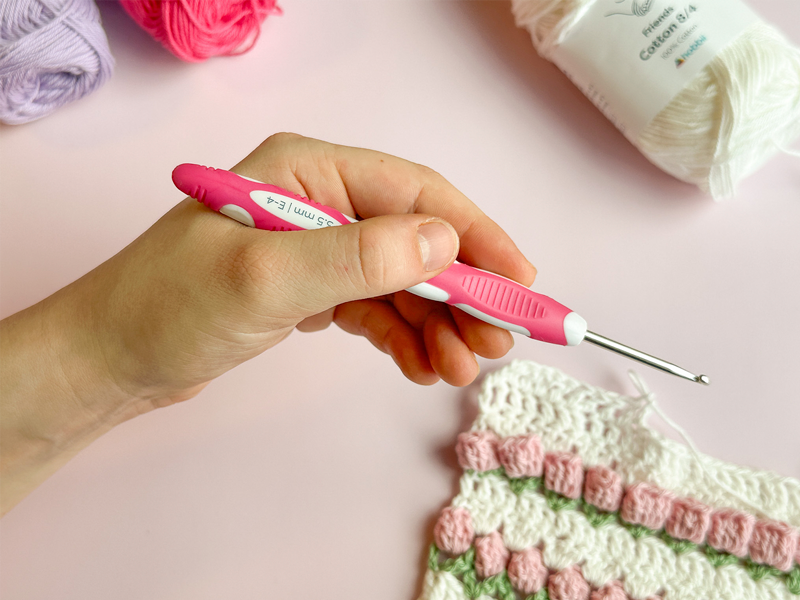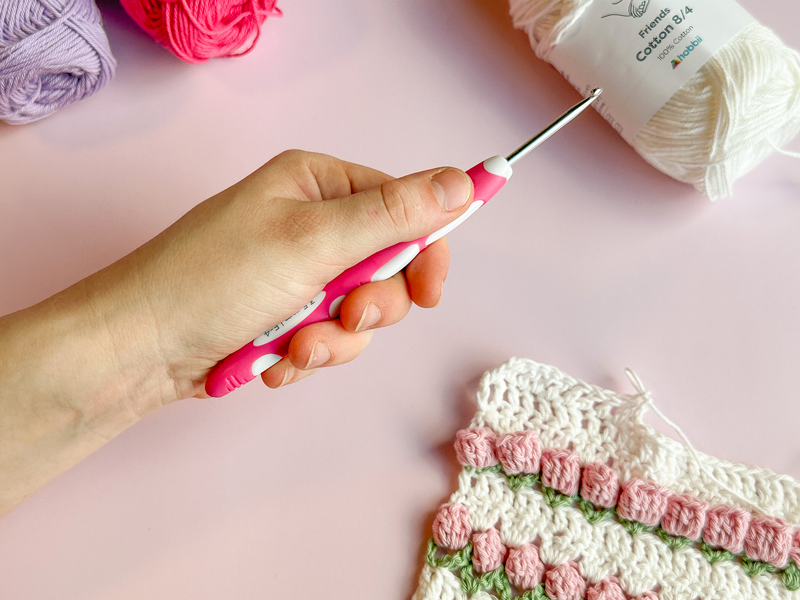Mastering the way you handle your yarn and crochet hook is essential for maintaining even tension and achieving a consistent crochet gauge. In this guide, we'll teach left-handed crafters the techniques for holding the yarn and crochet hook effectively, ensuring stunning outcomes with every project.

There's nothing more frustrating than spending hours on a project that ends up being too big, too small, or completely crooked and deformed.
Luckily, you can prevent such disappointments by mastering an even crochet gauge, starting with the fundamental technique of how you hold your yarn and crochet hook. The way you grip these tools plays a crucial role in the tension of your stitches, influencing whether your crochet is tight or loose. Additionally, a good grip can help prevent crochet injuries that force you to put your new hobby on the shelf for a while. 😱
In this blog post, we'll explore various grips for your yarn and crochet hook, tailored specifically for left-handers who are new to crocheting or those looking to refine their technique for a more uniform stitch tension.
First, let's dive into the correct way to hold your yarn. 🧶
Psst! Right-handers, don't feel lost; we've got tips and tricks to help you achieve a smooth crochet gauge in another post. Find it here!
Mastering Your Yarn Grip
There are no right or wrong ways to hold the yarn, but there are helpful guidelines to ensure your grip is effective:
Firstly, securing a firm grip on your yarn is crucial. Seek out a comfortable hold that allows you to maintain a consistent thread tension across your entire project.
GUIDE: The Gauge Swatch: How to Measure Your Crochet Tension
Second, you should be able to maintain your grip on the yarn without causing hand fatigue. A tired hand will affect your crochet gauge. But remember, it's completely normal to experience hand fatigue when you've just started crocheting. The key, regardless of experience level, is to periodically rest and gently stretch your hands.
Here's one way you might choose to hold your yarn:

In the picture, the yarn is wrapped around the little finger, after which the thread is led behind the index finger. This way, the thumb and ring finger can hold onto the piece that has already been crocheted.
Remember, there is no one correct way to hold the yarn. The most important factor is that it feels comfortable and natural to you. Exploring different methods is the best approach.
Mastering Your Crochet Hook Grip
There's a variety of ways to hold a crochet hook, and similarly to handling yarn, there's no single correct technique for everyone. The key is to find the grip that feels most natural and comfortable to you.
Nonetheless, most crocheters find success with one of two primary grips: the 'knife' grip or the 'pencil' grip. The names provide a clue to their execution—the 'knife' grip involves holding the hook as you would a knife, while the 'pencil' grip means holding it as if it were a pencil.
How to Hold Your Crochet Hook with the 'Knife' Grip

Here is how to do this: Grasp the crochet hook with your hand positioned over the hook, similar to holding a knife. Rest your index finger on the top of the hook for additional control.
Many crocheters prefer the 'knife' grip for its comfort and ease, particularly when starting out. This grip also offers the advantage of extra guidance from the index finger, making it a great choice for beginners.
How to Hold Your Crochet Hook with the 'Pencil' Grip

Here is how to do this: To achieve this grip, use your thumb, index, and middle fingers to hold the crochet hook.
Try out both the 'knife' and 'pencil' grips to discover which one suits you best.
After finding the grip that works for you, take a moment to consider the handle of your crochet hook. The market offers a vast selection of crochet hooks, and the design of the hook plays a crucial role in enhancing your crocheting experience. For those who crochet extensively, investing in an ergonomic hook, such as the Prym Ergonomic Crochet Hook or Clover's Soft Touch Crochet Hook, can make a significant difference, eventually feeling as if it were molded to your hand.
Psst! The crochet hook in the photo is the Duo Touch Crochet Hook. (You can also get in in a Crochet Hook set with 9 sizes).
A Few Helpful Tips
Improving your crochet experience and maintaining consistent stitch tension involves more than just hand positioning. Here are some extra tips along the way:
- Ensure a Comfortable Seating Arrangement: The way you sit significantly influences your muscle tension. Make sure you have ample space around you and avoid elbow armrests that could lead to an uneven posture or elevated shoulders. For added comfort, consider a crochet pillow to alleviate discomfort in the shoulders and elbows.
- Ensure Adequate Lighting: Adequate lighting can enhance your relaxation and focus on the project, preventing the need to squint or strain your eyes.
Ready to dive into crocheting? Continue with our specialized guide: Guide: Crocheting for Left-Handers.
Happy Crocheting! ❤️
